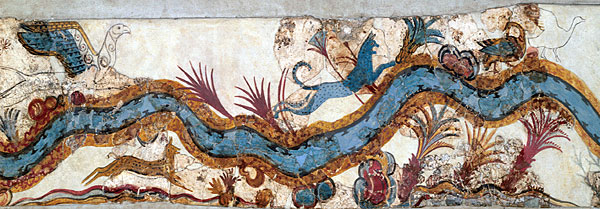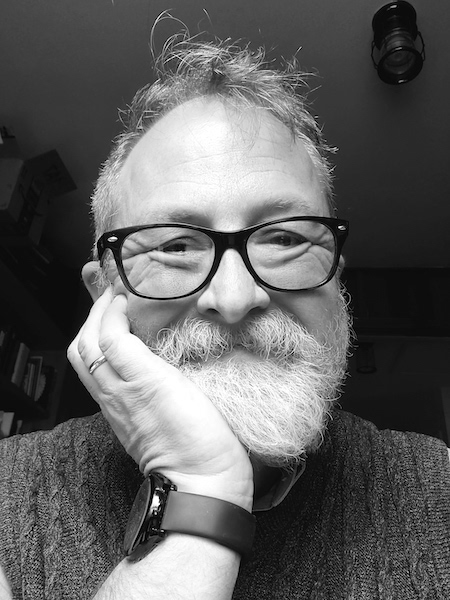Doug Van Gundy’s Poetry

“The man at the table across from mine/is eating a painting with a knife and fork./It looks to be a lesser Pollock, or perhaps/a Clyfford Still, regardless, abstract/expressionism, surprisingly modern/for a restaurant with linen tablecloths/and a live string ensemble serenading/the diners with Ravel’s Quartet in F Major./The painting is a stir-fry of colors/and the man licks his lips as he twirls/a strip of gessoed canvas onto his fork.”—By Doug Van Gundy
Speculative Friction
By Claire Bateman

Editor’s Note: Where do I even begin (here, I suppose) to express my gratitude for having met Claire Bateman back in the 1990s, when we were both (along with Emily Hipchen) teaching in Clemson University’s English Department. This column (featuring Doug Van Gundy) filed by Hubris’s there-from-the-beginning Poetry Editor, appeared here in December of 2022.
GREENVILLE South Carolina—(Hubris)—1 March 2023—West Virginia poet and musician Doug Van Gundy directs the low-residency MFA writing program at West Virginia Wesleyan College. His poems, essays, and reviews have appeared in many publications, including Poetry, The Guardian, and The Oxford American. He is co-editor of the anthology Eyes Glowing at the Edge of the Woods: Contemporary Writing from West Virginia, and the author of a collection of poems, A Life Above Water, and two chapbooks, The October Poems and Pictures & Poems, a collaboration with photographer Matt Eich. Gundy is also a respected traditional musician, and plays fiddle, guitar, mandolin, and harmonica in the old-time string duo, Born Old. He has won many awards for his fiddle and banjo playing.
![]()
Etiquette
The man at the table across from mine
is eating a painting with a knife and fork.
It looks to be a lesser Pollock, or perhaps
a Clyfford Still, regardless, abstract
expressionism, surprisingly modern
for a restaurant with linen tablecloths
and a live string ensemble serenading
the diners with Ravel’s Quartet in F Major.
The painting is a stir-fry of colors
and the man licks his lips as he twirls
a strip of gessoed canvas onto his fork.
He is obviously insane as everyone knows
the proper way to eat a painting
is with the bare hands, lifting it
to your mouth with your fingers then
dismantling it with your teeth.
![]()
Three Views of Helen Frankenthaler’s The Human Edge
Everson Museum of Art, Syracuse, NY
I. The canvas is licked by natural light,
the orange warming and cooling
with the passing clouds and changing
seasons. Diagonals of sunlight
make triangles and trapezoids
of Frankenthaler’s austere verticals.
It’s one of the first things you see
when you walk into the museum,
hanging alone on the textured concrete
opposite the kiosk and gift shop,
reminding you you’re in the presence
of Important American Art. This morning
the blue at the bottom (ocean? river? slate?)
is all in shadow, as if a storm is coming
or perhaps, just now passing.
II. I was upstairs in the galleries, looking
at Sharif Bey’s minkisi, Congolese power
figures rendered through the lens
of a Pittsburgh childhood and
the Manchester Craftsman’s Guild.
As I was thrumming with shared
recognition (the nkisi nkondi Bey
saw as a child at the Carnegie Museum
haunts my dreams as well) I felt the pressure
of another’s gaze. When I entered
the hallway, I could see into the atrium
and the Frankenthaler painting
was staring at me from the corner
of its pink and grey eye.
III. After all of the paintings
and photographs, the ceramics
and sculptures, I found myself
standing face-to-face with The Human
Edge once again. The simple planes
of color — grey and orange and black
and pink and blue — echoed the vessels
and garments, the images and tableau
that had been pouring into my head
through my hungry retinas for the last
several hours. The Frankenthaler seemed
satisfied. It seemed to be saying, see?
I wanted to show you these things and now
you have seen them. Go into the world.
![]()
Childhood is a Country Without Borders
Childhood is the only period of our lives
that makes up the entirety
of our lives.
I remember the moment I knew there was an interior
and exterior narrative
in my story.
There isn’t any part of me that isn’t clothed
by memories and lessons
I collected as a boy.
Most of what I know and think and believe
I have never shared
with anyone.
I cry out, I listen, I cajole, I seduce, I forget
that aloneness and loneliness
are the defaults.
Beyond what I have seen, there is nothing
that isn’t part of the landscape
of my childness.
Fearless or frightened, wounded or kind,
I am still that boy from
edge to edge.
Childhood is the only period of our lives
that makes up our lives
entirely.
![]()
Last Thoughts on Electronic Voice Projection
My grandmother calls less and less frequently
since she died, and when she does, it’s always to complain:
she is cold, she is hungry, the coroner has made a mistake,
that sort of thing. I listen as patiently as I can; I’m still in love
with the music of her voice. While she was alive, she’d sing
big band standards in her nasal soprano, the whole time
stuffing pork chops or washing the dishes,
until I’d slip an arm around her back and waltz her
around the linoleum: me taking over the singing, she giggling
like a little girl and dripping soap
from the waterlogged rag in her hand. Now her voice
is ossifying through the degrees, getting thinner and thinner –
now FM, now AM. Finally, she’ll open her mouth
on the wordless static of the stationless radio or interstellar space.
One day, I’ll answer the phone and hear even less
than the background sound of the line, only the silence
behind the silence, my memory of her having gone
as voiceless as a doll.
—This poem first appeared in Still: The Journal.
![]()
A People’s History of Randolph Co., WV
Imagine how it used to be.
All that remains now are stones and ghosts. You can’t
look at the old topographical maps and see
the places where the miners used to live
even the names of the settlements are missing:
Jeff Scotts, Laurel, Roaring Creek Junction.
If you go there today,
bush-whack through briers and joe-pye.
You will have to
dig into the ground to find anything
to prove that people ever even lived here.
To prove that people ever even lived here,
dig into the ground. To find anything
you will have to
bush-whack through briers and joe-pye
if you go there today.
Jeff Scotts, Laurel, Roaring Creek Junction:
even the names of the settlements are missing,
the places where the miners used to live.
Look at the old topographical maps and see:
all that remains now are stones and ghosts. You can’t
imagine how it used to be.
—This poem first appeared in Kestrel.
![]()
To order copies of Claire Bateman’s books Scape or Coronology from Amazon, click on the book covers below.

